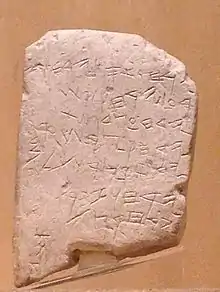| Part of a series on the |
| Bible |
|---|
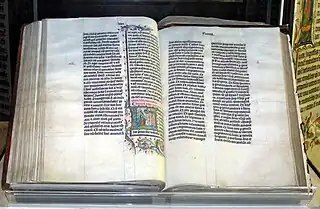 |
|
Outline of Bible-related topics |
The following is a list of inscribed artifacts, items made or given shape by humans, that are significant to biblical archaeology.
Selected artifacts significant to biblical chronology
This table lists inscriptions which are of particular significance to the study of biblical chronology. References are from ANET[1] and COS[2] and link to editio princeps (EP), if known.
Egyptian
| Name | Image | Current location | Discovered | Date | Writing | Significance | Refs |
|---|---|---|---|---|---|---|---|
| Autobiography of Weni |  |
Cairo Museum | 1880, Abydos | c.2280 BC | Egyptian hieroglyphs | Records the earliest known Egyptian military campaigns in Sinai and the Levant. | ANET 227–228 |
| Sebek-khu Stele | 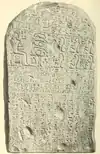 |
Manchester Museum | 1901, Abydos | c.1860 BC | Egyptian hieroglyphs | Records the earliest known Egyptian military campaign in Retjenu, including Sekmem (s-k-m-m, thought to be Shechem). | ANET 230 |
| Merneptah Stele | .jpg.webp) |
Cairo Museum | 1896, Thebes | c. 1209 BC | Egyptian hieroglyphs | The text is largely an account of a military campaign against the ancient Libyans, but the last three of the 28 lines deal with a separate campaign in Canaan, including the first documented instance of the name Israel in the historical record, and the only documented record in Ancient Egypt. | COS 2.6 / ANET 376–378 / EP[3] |
| Bubastite Portal | 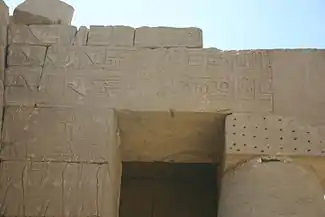 |
Original location | 1828, Karnak | c. 925 BC | Egyptian hieroglyphs | Records the conquests and military campaigns in c.925 BC of Shoshenq I, of the Twenty-second Dynasty, identified with the biblical Shishaq. Towns identified include Rafah (rph), Megiddo (mkdi) and Ajalon (iywrn) | ANET 242–243 |
Other significant Egyptian artifacts
- Execration texts – earliest references to many Biblical locations
- Papyrus Brooklyn 35.1446 – A document that lists the names of 45 individuals, including a Canaanite woman named "Šp-ra." Scholars assume that this is a hieroglyphic transliteration of the Hebrew name "Shiphrah," which also appears in Exodus 1:15–21. However, while the name may be related, the document dates to c. 1833–1743 BCE (centuries before the biblical Shiphra would have lived).[4][5]
- Ipuwer Papyrus – poem describing Egypt as afflicted by natural disasters and in a state of chaos. The document is dated to around 1250 BC[6] but the content is thought to be earlier, dated back to the Middle Kingdom, though no earlier than the late Twelfth Dynasty.[7] Once thought to describe the biblical Exodus, it is now considered the world's earliest known treatise on political ethics, suggesting that a good king is one who controls unjust officials, thus carrying out the will of the gods.[8]
- Berlin pedestal relief – considered by many modern scholars to contain the earliest historic reference to ancient Israel.[9][10] Experts remain divided on this hypothesis.[11]
Cuneiform
| Name | Image | Current location | Discovered | Date | Writing | Significance | Refs |
|---|---|---|---|---|---|---|---|
| Statue of Idrimi | 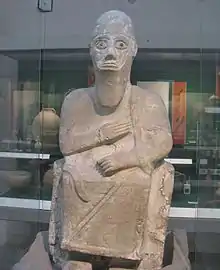 |
British Museum | 1939, Alalakh | c.1500 BC | Akkadian cuneiform | Records the earliest certain cuneiform reference to Canaan | ANET 557 |
| Kurkh Monoliths | 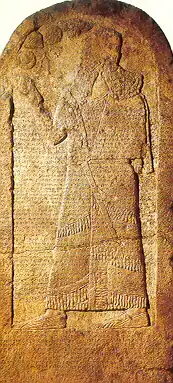 |
British Museum | 1861, Üçtepe, Bismil | c.850 BC | Assyrian cuneiform | The Shalmaneser III monolith contains a description of the Battle of Qarqar at the end. This description contains the name "A-ha-ab-bu Sir-ila-a-a" which is generally accepted to be a reference to Ahab king of Israel,[12][13] although it is the only known reference to the term "Israel" in Assyrian and Babylonian records, a fact brought up by some scholars who dispute the proposed translation. | COS 2.113A / ANET 277-278 |
| Black Obelisk of Shalmaneser III | 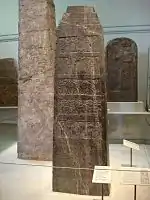 |
British Museum | 1846, Nimrud | c.825 BC | Assyrian cuneiform | Contains what is thought to be the earliest known picture of a biblical figure: possibly Jehu son Omri (mIa-ú-a mar mHu-um-ri-i), or Jehu's ambassador, kneeling at the feet of Shalmaneser III. | COS 2.113F / ANET 278–281 |
| Saba'a Stele | 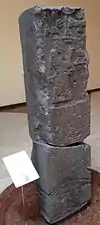 |
Istanbul Archaeology Museums | 1905, Saba'a | c.800 BC | Assyrian cuneiform | Records Adad-nirari III's Assyrian campaign to Pa-la-áš-tu (Philistia) | COS 2.114E / ANET 282 / EP[14] |
| Nimrud Slab | _Inscription.png.webp) |
Unknown | 1854, Nimrud | c.800 BC | Akkadian cuneiform | Describes Adad-nirari III's early Assyrian conquests in Palastu (Phillistia), Tyre, Sidon, Edom and Humri (the latter understood as the Kingdom of Israel (Samaria)). | COS 2.114G[15] |
| Nimrud Tablet K.3751 | 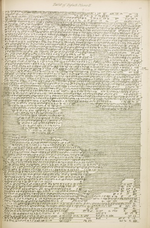 |
British Museum | c.1850, Nimrud | c.733 BC | Akkadian cuneiform | Describes Tiglath-Pileser III's (745 to 727 BC) campaigns to the region, including the first known archeological reference to Judah (Yaudaya or KUR.ia-ú-da-a-a). | COS 2.117 / ANET 282–284 |
| Sargon II's Prism A | 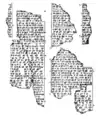 |
British Museum | c.1850, Library of Ashurbanipal | c.710 BC | Akkadian cuneiform | Describes Sargon II's (722 to 705 BC) campaigns to Palastu, Judah, Edom and Moab. | COS 2.118i / ANET 287 |
| Lachish relief |  |
British Museum | 1845, Nineveh | c.700 BC | Assyrian cuneiform | Portion of the Sennacherib relief, which depicts captives from Judah being led into captivity after the Siege of Lachish in 701 BC | COS 2.119C / EP[16] |
| Azekah Inscription | 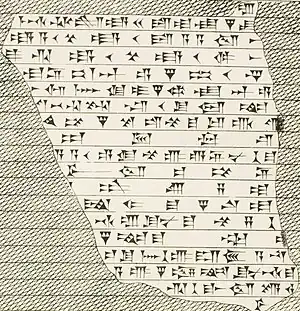 |
British Museum | c.1850, Library of Ashurbanipal | c.700 BC | Akkadian cuneiform | Describes an Assyrian campaign by Sennacherib against Hezekiah, King of Judah, including the conquest of Azekah. | COS 2.119D |
| Sennacherib's Annals | 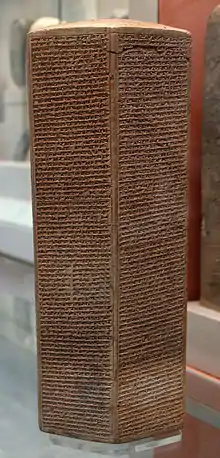 |
British Museum, Oriental Institute of Chicago, and the Israel Museum | 1830, likely Nineveh, unprovenanced | c.690 BC | Assyrian cuneiform | Describes the Assyrian king Sennacherib's siege of Jerusalem in 701 BC during the reign of king Hezekiah. | COS 2.119B / ANET 287–288 |
| Esarhaddon's Treaty with Ba'al of Tyre | .png.webp) |
British Museum | c.1850, Library of Ashurbanipal | c.675 BC | Akkadian cuneiform | Describes a treaty between Esarhaddon (reigned 681 to 669 BC) and Ba'al of Tyre with respect to pi-lis-te | COS 2.120 / ANET 533 |
| Cylinders of Nabonidus |  |
British Museum and Pergamon Museum | 1854, Ur | c.550 BC | Akkadian cuneiform | Describes Belshazzar (Balthazar) as Nabonidus' eldest son | COS 2.123A |
| Nebuchadnezzar Chronicle |  |
British Museum | 1896 (acquired), unprovenanced | c.550 – 400 BC [17] | Akkadian cuneiform | Describes Nebuchadnezzar's first siege of Jerusalem in 597 BC, the Siege of Jerusalem (597 BC) | COS 1.137 / ANET 301–307 |
| Cylinder of Cyrus | 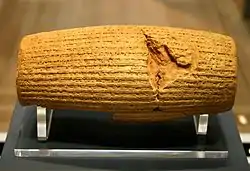 |
British Museum | 1879, Babylon | c.530 BC | Akkadian cuneiform | King Cyrus's treatment of religion, which is significant to the books of Chronicles, Ezra and Nehemiah. | COS 2.124 / ANET 315–316 |
| Nabonidus Chronicle |  |
British Museum | 1879 (acquired), Sippar, unprovenanced | 4th –1st century BC[18] | Akkadian cuneiform | Describes the conquest of Babylon by the Persian king Cyrus the Great | COS 1.137 / ANET 301–307 / EP[19] |
Other significant Cuneiform artifacts
- Creation myths and flood myths – recorded on the Epic of Gilgamesh, the Atra-Hasis tablets, the Enûma Eliš, the Eridu Genesis and the Barton Cylinder
- Law tablets – ancient Near East legal tablets: Code of Hammurabi, Laws of Eshnunna, the Code of Ur-Nammu, king of Ur (c. 2050 BC), the Laws of Eshnunna (c. 1930 BC) and the Code of Lipit-Ishtar of Isin (c. 1870 BC).[20] Later codes than Hammurabi's include the Code of the Nesilim.[21] Hittite laws, the Assyrian laws, and Mosaic Law / Ten Commandments. (see Cuneiform law).
- Tell al-Rimah stela (c. 780 BC) – tells of the exploits of Adad-nirari III, mentioning "Joash King of Samaria"[22]
- Annals of Tiglath-Pileser III (740–730 BC):
- Layard 45b+ III R 9,1 possibly refers to [KUR sa-me-ri-i-na-a-a] as ["land of Samaria"][23]
- The Iran Stela refers to KUR sa-m[e]-ri-i-na-a-[a] "land of Samaria"[23]
- Layard 50a + 50b + 67a refers to URU sa-me-ri-na-a-a "city of Samaria"[23]
- Layard 66 refers to URU Sa-me-ri-na "city of Samaria"[23]
- III R 9.3 50, refers to "Menahem the Samarian"[22][24]
- Nimrud Tablet III R 10.2 28–29, refers to the overthrown of Pekah by Hoshea.[22][24]
- one fragment refers to "Azriau" and another it has been joined to refers to "Yaudi". Some scholars have interpreted this as Ahaziah / Uzziah, although this is disputed and has not gained scholarly consensus.[25][26][27][28]
- III R 10,2 refers to KUR E Hu-um-ri-a "land of Bit-Humri"[23]
- ND 4301 + 4305 refers to KUR E Hu-um-ri-a "land of Bit-Humri"[23]
- Babylonian Chronicle ABC1 (725 BC) – Shalmaneser V refers to URU Sa-ma/ba-ra-'-in "city of Samar(i)a"[23]
- Annals of Sargon II (720 BC):
- Victory stele of Esarhaddon – a dolerite[29] stele commemorating the return of Esarhaddon after his army's second battle and victory over Pharaoh Taharqa in northern ancient Egypt in 671 BC, discovered in 1888 in Zincirli Höyük (Sam'al, or Yadiya) by Felix von Luschan and Robert Koldewey. It is now in the Pergamon Museum in Berlin.
- Esarhaddon's Succession Treaty (written around 675 BCE) – Some scholars think that this treaty served as a literary model for the curses in Deuteronomy 28:15–64, as well as content in Deuteronomy 13, due to strong textual similarities.[30][31]
- Nebo-Sarsekim Tablet (circa 595 BC) – a clay cuneiform inscription referring to an official at the court of Nebuchadrezzar II, king of Babylon, possibly the same official named in the Biblical Jeremiah.
- Jehoiachin's Rations Tablets (6th century BC) – Describe the rations set aside for a royal captive identified with Jehoiachin, king of Judah (Cf. 2 Kings 24:12,15–16; 25:27–30; 2 Chronicles 36:9–10; Jeremiah 22:24–26; 29:2; 52:31–34; Ezekiel 17:12).[32]
Canaanite and Aramaic
| Name | Image | Current location | Discovered | Date | Writing | Significance | Refs |
|---|---|---|---|---|---|---|---|
| Mesha Stele | 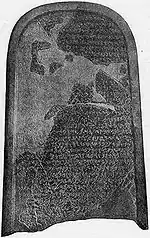 |
Louvre | 1868, Dhiban, Jordan | c.850 BC | Moabite language | Describes the victories of Moabite king Mesha over the House of Omri (kingdom of Israel). It bears the earliest certain extra-biblical reference to the Israelite god Yahweh, and—if French scholar André Lemaire's reconstruction of a portion of line 31 is correct—the earliest mention of the "House of David" (i.e., the kingdom of Judah). One of the only two known artifacts containing the "Moabite" dialect of Canaanite languages (the second is the El-Kerak Inscription) | COS 2.23 / ANET 320–321 |
| Tel Dan Stele |  |
Israel Museum | 1993, Tel Dan | c.800 BC | Old Aramaic | Significant as an extra-biblical corroboration of Israel's past, particularly in lines 8 and 9, which mention a "king of Israel" and a "house of David". The latter is generally understood by scholars to refer to the ruling dynasty of Judah. Although the meaning of this phrase has been disputed by a small minority of scholars,[33] today it is generally accepted as a reference to the Davidic dynasty.[34][35][36][37] | |
| Siloam inscription |  |
Istanbul Archaeology Museums | 1880, Siloam tunnel | c.701 BC | Paleo-Hebrew | Records the construction of Siloam tunnel | COS 2.28 / ANET 321 |
| LMLK seals | 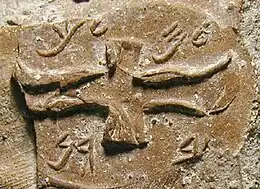 |
Various | 1870 onwards | c.700 BC | Phoenician alphabet (also known as Paleo-Hebrew) | c.2,000 stamp impressions, translated as "belonging to the King" | COS 2.77 / EP[38] |
| Ekron inscription | 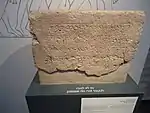 |
Israel Museum | 1996, Ekron | c.650 BC | Phoenician alphabet | The first known inscription from the area ascribed to Philistines | COS 2.42 |
| Trumpeting Place inscription | 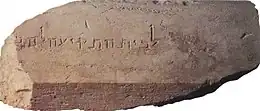 |
Israel Museum | 1968, Jerusalem | c.1st century AD | Hebrew[39] | Believed to be a directional sign for the priests who blew a trumpet, consistent with an account in Josephus | |
Other significant Canaanite and Aramaic artifacts
- Early Paleo-Hebrew writing – contenders for the earliest Hebrew inscriptions include the Gezer calendar, Biblical period ostraca at Elah and Izbet Sartah,[40] and the Zayit Stone
- Pim weight – evidence of the use of an ancient source for the Book of Samuel due to the use of an archaic term.
- Khirbet Qeiyafa ostracon – 10th century BC inscription – both the language it is written in and the translation are disputed. Was discovered in excavations near Israel's Elah valley.[41]
- Tell es-Safi inscription (10th to mid 9th centuries BC) – Potsherd inscribed with the two names "alwt" and "wlt", etymologically related to the name Goliath and demonstrate that the name fits with the context of late-tenth/early-ninth-century BC Philistine culture. Found at Tell es-Safi, the traditional identification of Gath.
- Ophel pithos is a 3,000-year-old inscribed fragment of a ceramic jar found near Jerusalem's Temple Mount by archeologist Eilat Mazar. It is the earliest alphabetical inscription found in Jerusalem written in what was probably Proto-Canaanite script.[42] Some scholars believe it to be an inscription of the type of wine that was held in a jar.[43]
- Amman Citadel Inscription – 9th century BC inscription in the Ammonite language, one of the few surviving written records of Ammon.
- Melqart stele – (9th–8th century BC) William F. Albright identifies Bar-hadad with Ben-hadad I, who was a contemporary of the biblical Asa and Baasha.
- Ostraca House – (probably about 850 BC, at least prior to 750 BC) 64 legible ostraca found in the treasury of Ahab – written in early Hebrew.
- Deir Alla Inscription (c. 840–760 BC)[44] 9th or 8th century BC inscription about a prophet named Balaam (cf. the Book of Numbers).[45]
- Kuntillet Ajrud inscriptions – (9th–8th century BC) inscriptions in Phoenician script including references to Yahweh.
- Sefire steles (8th century BC) – described as "the best extrabiblical source for West Semitic traditions of covenantal blessings and curses".[46]
- Stele of Zakkur (8th century BC) – Mentions Hazael king of Aram.
- Shebna Inscription (8th–7th century BC?) – found over the lintel or doorway of a tomb, has been ascribed to Hezekiah's comptroller Shebna.
- King Ahaz's Seal (732 to 716 BC) – Ahaz was a king of Judah but "did not do what was right in the sight of the Lord his God, as his ancestor David had done" (2 Kings 16:2; 2 Chronicles 28:1). He worshiped idols and followed pagan practices. "He even made his son pass through fire, according to the abominable practices of the nations" (2 Kings 16:3). Ahaz was the son and successor of Jotham.
- Bullae (c. 715–687 BC or 716–687 BC)[47] (clay roundels impressed with a personal seal identifying the owner of an object, the author of a document, etc.) are, like ostraka, relatively common, both in digs and on the antiquities market. The identification of individuals named in bullae with equivalent names from the Bible is difficult, but identifications have been made with king Hezekiah[48] and his servants (????? avadim in Hebrew, [עבדים - slaves])
- Bulla of Gemariah son of Shaphan (r. 609–598 BC) – possible link to a figure during the reign of Jehoiakim (Jeremiah 36:10). Archaeologist Yair Shoham notes: "It should be borne in mind, however, that the names found on the bullae were popular in ancient times and it is equally possible that there is no connection between the names found on the bullae and the person mentioned in the Bible."[49]
- Seal of Jehucal (7th century BC) – Jehucal or Jucal is mentioned in chapters 37 and 38 of the Book of Jeremiah where King Zedekiah sends Jehucal son of Shelemiah and the priest Zephaniah son of Maaseiah to the prophet Jeremiah saying "Please pray for us to the Lord our God" (Jeremiah 37:3). His seal and also one of Gedaliah, son of Pashhur (also mentioned in Jeremiah 38:1 together with Jehucal) were found within a few yards from each other during excavations in the city of David, Jerusalem, in 2005 and 2008, respectively, by Eilat Mazar.[50]
- Khirbet Beit Lei graffiti contains oldest known Hebrew writing of the word "Jerusalem", dated to 7th century BC "I am YHWH thy Lord. I will accept the cities of Judah and I will redeem Jerusalem" "Absolve us oh merciful God. Absolve us oh YHWH"[51]
- Yavne-Yam ostracon is an inscribed pottery fragment dated to 7th century BC and written in ancient Hebrew language. It contains earliest extra-biblical reference to the observance of Shabbat.[52][53]
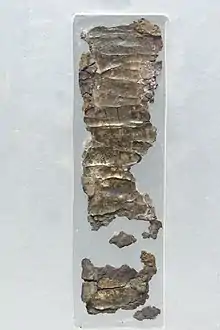
Ketef Hinnom Priestly Blessing
- Ketef Hinnom scrolls – Probably the oldest surviving texts currently known from the Hebrew Bible – priestly blessing dated to 600 BC.[54] Text from the Book of Numbers in the Old Testament. Described as "one of most significant discoveries ever made" for biblical studies.[55][56]
- Lachish letters – letters written in carbon ink by Hoshaiah (cf. Nehemiah 12:32, Jeremiah 42:1, 43:2), a military officer stationed near Jerusalem, to Joash the commanding officer at Lachish during the last years of Jeremiah during Zedekiah's reign (c.588 BC) (see Jeremiah 34:7). Lachish fell soon after, two years before the fall of Jerusalem.[57]
- Lachish ewer: a pot with sacred trees and more, often mentioned in academic discussion
- Arad ostraca: the "House of Yahweh" ostracon is an ancient pottery fragment discovered at Tel Arad probably referring to the Temple at Jerusalem.[58]
- Elephantine papyri, ancient Jewish papyri dating to the 5th century BC, name three persons mentioned in Nehemiah: Darius II, Sanballat the Horonite and Johanan the high priest.
- Hasmonean coinage (164 BC – 35 BC)
Greek and Latin
| Name | Image | Current location | Discovered | Date | Writing | Significance | Refs |
|---|---|---|---|---|---|---|---|
| Temple Warning inscription | 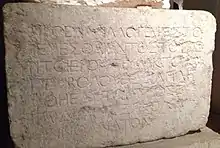 |
Istanbul Archaeology Museums | 1871, Jerusalem | c.23 BC – 70 AD | Greek | Believed to be an inscription from Herod's Temple, warning foreigners ("allogenē") to refrain from entering the Temple enclosure | |
| Arch of Titus | 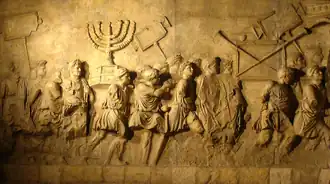 |
Original location | n.a., Rome | c.82 AD | Latin | Relief showing spoils from the Sack of Jerusalem by Titus in 70 AD. Depicted are the menorah and trumpets, as well as what might be the Table of Showbread. | |
Other significant Greek and Latin artifacts
- Pilate Stone (c. 36 AD) – carved inscription attributed to Pontius Pilate, a prefect of the Roman-controlled province of Judaea from 26 to 36 AD.
- Delphi Inscription (c. 52 AD) – The reference to proconsul Gallio in the inscription provides an important marker for developing a chronology of the life of Apostle Paul by relating it to the trial of Paul in Achaea mentioned in the Acts of the Apostles (18:12–17).
- Erastus Inscription (Roman period) – an inscription found in 1929 near a paved area northeast of the theater of Corinth, dated to the mid-first century and reads "Erastus in return for his aedileship paved it at his own expense."[59] Some New Testament scholars have identified this aedile Erastus with the Erastus mentioned in the Epistle to the Romans but this is disputed by others.[60][61]
- Judaea Capta coinage (after 70 AD) – a series of commemorative coins originally issued by the Roman Emperor Vespasian to celebrate the capture of Judaea and the destruction of the Jewish Second Temple by his son Titus in 70 AD during the First Jewish Revolt.
- Nazareth Inscription bears an edict of Caesar prohibiting grave robbing.
Controversial (forgery, claimed forgery, or identification disputed)
- Ebla tablets – once thought to have made references to, and thus confirmed, the existence of Abraham, David, Sodom and Gomorrah among other Biblical references.
- Uzziah Tablet (8th century BC or 30–70 AD?) – controversial tablet discovered in 1931 by Professor E. L. Sukenik of the Hebrew University of Jerusalem in a Russian convent.
- Jehoash Inscription – controversial black stone tablet in Phoenician regarding King Jehoash's repair work. Suspected to be a forgery.
- Ivory pomegranate – a thumb-sized semitic ornamental artifact bears an inscription: "Holy (sacred) to the Priest of the House of God (YHWH)", thought to have adorned the High Priest's sceptre within the Holy of Holies. Suspected to be a forgery.
- James Ossuary – a 1st-century limestone box that was used for containing the bones of the dead, bearing an Aramaic inscription in the Hebrew alphabet, "James, son of Joseph, brother of Jesus", cut into one side of the box. Suspected to be a forgery.
- Caiaphas ossuary – a highly decorated ossuary twice inscribed "Joseph, son of Caiaphas" which held the bones of a 60-year-old male, discovered in a burial cave in south Jerusalem in November 1990.
- Miriam ossuary – a decorated ossuary inscribed "Miriam, daughter of Yeshua, son of Caiaphas", found in a tomb in the Valley of Elah in 2011.
- Titulus Crucis – a piece of wood claimed to be a relic of the True Cross, which Christian tradition holds to be a part of the cross's titulus (inscription), now kept in the church of Santa Croce in Gerusalemme in Rome. Radiocarbon dating tests on the artifact have shown that it dates between 980 and 1146 AD.
- Shapira Scroll, leather strips containing a somewhat different text of the Ten Commandments, belonging to Moses Wilhelm Shapira, a Jerusalem antiquities dealer. Widely discredited following its 1883 release, resulting in Shapira's suicide. Has been reassessed following the 1946 discovery of the Dead Sea Scrolls.
- Shapira collection – other biblical artifacts in the possession and allegedly forged by Moses Shapira.[62][63] The discovery of the Dead Sea scrolls in 1947, in approximately the same area he claimed his material was discovered, has cast some doubt on the original forgery charges.[62][63]
- Seal of Manasseh – Stone seal of Manasseh, King of Judah c.687–642 BC. Reportedly offered to a private collector for one million dollars.[64]
- Seal of Gedaliah
- Seal of Neriah
- Seal of Ahaz
Significant museums
Concordance of external lists
- ANET: Ancient Near Eastern Texts Relating to the Old Testament. Third Edition with Supplement. Ed. James B. Pritchard. Princeton: Princeton Univ. Press, 1969
- COS: The Context of Scripture. 3 volumes. Eds. William W. Hallo and K. Lawson Younger. Leiden: Brill, 1997-2002
| Inscription | COS | ANET | ||
|---|---|---|---|---|
| Ref. | Title | Ref. | Title | |
| Pyramid Texts | 1.4 | Pyramid Texts Spell 600 | 3 | The Creation by Atum |
| 1.9 | Papyrus Bremer-Rind | 6-7 | The Repulsing of the Dragon and the Creation | |
| Shabaka Stone | 1.15 | The "Memphite Theology" | 4-6 | The Theology of Memphis |
| 1.17 | Coffin Texts Spell 1130 | 7-8 | All Men Created Equal in Opportunity | |
| Book of the Dead | 1.18 | Book of the Dead 175 | 9-10 | The Primeval Establishment of Order |
| Coffin Texts | 1.19 | Coffin Text 157 | 10 | The Mythological Origin of Certain Unclean Animals |
| 1.21 | The Repulsing of the Dragon | 11-12 | The Repulsing of the Dragon | |
| 1.22 | The Legend of Isis and the Name of Re | 12-14 | The God and His Unknown Name of Power | |
| 1.23 | The Legend of Astarte and the Tribute of the Sea | 17-18 | Astarte and the Tribute of the Sea | |
| Book of the Heavenly Cow | 1.24 | The Destruction of Mankind | 10 | Deliverance of Mankind from Destruction |
| Great Hymn to the Aten | 1.25 | The Great Cairo Hymn of Praise to Amun-Re | 365-367 | A Hymn to Amon-Re |
| 1.27 | Two Hymns to the Sun-god | 367-368 | A Universalist Hymn to the Sun | |
| 1.28 | The Great Hymn to the Aten | 369-371 | The Hymn to the Aton | |
| Harper's Songs | 1.30 | The Song from the Tomb of King Intef | 467 | A Song of the Harper |
| 1.31 | The Song from the Tomb of Neferhotep | 33-34 | The Good Fortune of the Dead | |
| Execration texts | 1.32 | Execration Texts | 328-329 | The Execration of Asiatic Princes |
| 1.33 | Dream Oracles | 495 | The Interpretation of Dreams | |
| 1.34 | Daily Ritual of the Temple of Amun-Re at Karnak | 325-326 | The Daily Ritual in the Temple | |
| Teaching for King Merykara | 1.35 | Merikare | 414-418 | The Instruction for King Meri-ka-re |
| Instructions of Amenemhat | 1.36 | Amenemhet | 418-419 | The Instruction of King Amen-em-het |
| Story of Sinuhe | 1.38 | Sinuhe | 18-22 | The Story of Si-nuhe |
| Tale of Two Brothers | 1.40 | The Two Brothers | 23-25 | The Story of Two Brothers |
| Story of Wenamun | 1.41 | The Report of Wenamun | 25-29 | The Journey of Wen-Amon to Phoenicia |
| Ipuwer Papyrus | 1.42 | The Admonitions of an Egyptian Sage: the Admonitions of Ipuwer | 441-444 | The Admonitions of Ipu-wer |
| The Eloquent Peasant | 1.43 | The Eloquent Peasant | 407-410 | The Protests of the Eloquent Peasant |
| Instruction of Any | 1.46 | Instruction of Any | 420-421 | The Instruction of Ani |
| Instruction of Amenemope | 1.47 | Instruction of Amenemope | 421-424 | The Instruction of Amen-em-Opet |
| The Satire of the Trades | 1.48 | Dua-khety or the Satire on the Trades | 432-434 | The Satire on the Trades |
| Famine Stela | 1.53 | The Famine Stela | 31-32 | The Tradition of Seven Lean Years in Egypt |
| Bentresh stela | 1.54 | The Legend of the Possessed Princess ("Butresh Stela”) | 29-31 | The Legend of the Possessed Princess |
| 1.55 | Elkunirsa and Asertu | 519 | El, Ashertu and the Storm-god | |
| Illuyanka | 1.56 | The Storm-god and the Serpent (Iluyanka) | 125-126 | The Myth of Iluyankas |
| Telipinu | 1.57 | The Wrath of Telipinu | 126-128 | The Telepinus Myth |
| Muršili II | 1.60 | Plague Prayers of Mursili II | 394-396 | Plague Prayers of Mursilis |
| 1.63 | Uhhamuwa's Ritual Against Plague | 347 | Ritual Against Pestilence | |
| Hittite military oath | 1.66 | The First Soldiers' Oath | 353-354 | The Soldiers' Oath |
| Šuppiluliuma I | 1.74 | Deeds of Suppiluliuma | 319 | Suppiluliumas and the Egyptian Queen |
| 1.83 | Instructions to Priests and Temple Officials | 207-210 | Instructions for Temple Officials | |
| 1.84 | Instructions to Commanders of Border Garrisons | 210-211 | From the Instructions for the Commander of the Border Guards | |
| Baal Cycle | 1.86 | The Ba`lu Myth | 129-142 | Poems about Baal and Anath |
| Legend of Keret | 1.102 | The Kirta Epic | 142-149 | The Legend of King Keret |
| Tale of Aqhat | 1.103 | The 'Aqhatu Legend | 149-155 | The Tale of Aqhat |
| 1.108 | The Descent of Ishtar to the Underworld | 106-109 | Descent of Ishtar to the Nether World | |
| 1.109 | Nergal and Ereshkigal | 507-512 | Nergal and Ereshkigal | |
| 1.110 | Nergal and Ereshkigal (Amarna Version) | 103-104 | Nergal and Ereshkigal | |
| Enūma Eliš | 1.111 | Epic of Creation | 60-72, 501-503 | The Creation Epic |
| Dynasty of Dunnum | 1.112 | The Theogony of Dunnu | 517-518 | A Babylonian Theogony |
| 1.115 | Prayer to Gods of the Night | 390-391 | Prayer to the Gods of the Night | |
| Great Prayer to Šamaš | 1.117 | The Shamash Hymn | 387-389 | Hymn to the Sun-god |
| 1.129 | The Adapa Story | 101-103 | Adapa | |
| Atra-Hasis | 1.130 | Atra-Hasis | 104-106, 512-514 | Atrahasis |
| 1.131 | Etana | 114-118, 517 | Etana | |
| Epic of Gilgamesh | 1.132 | Gilgamesh | 72-99, 503-507 | The Epic of Gilgamesh |
| 1.133 | The Birth Legend of Sargon of Akkad | 119 | The Legend of Sargon | |
| 1.134 | Babylonian King Lists | 271, 272, 566-567 | The Babylonian King List B, The Babylonian King List A, A Seleucid King List | |
| 1.135 | Assyrian King Lists | 564-566 | The Assyrian King List | |
| Babylonian Chronicles | 1.137 | Babylonian Chronicle | 301-307 | The Neo-Babylonian Empire and its Successors |
| 1.143 | An Assurbanipal Hymn for Shamash | 386-387 | Prayer of Ashurbanipal to the Sun-God | |
| Adad-guppi | 1.147 | The Adad-Guppi Autobiography | 560-562 | The Mother of Nabonidus |
| Ludlul bēl nēmeqi | 1.153 | The Poem of the Righteous Sufferer | 596-600; 434 | Ludlul Bēl Nēmeqi |
| Babylonian Theodicy | 1.154 | The Babylonian Theodicy | 601-604 | The Babylonian Theodicy |
| Dialogue of Pessimism | 1.155 | Dialogue of Pessimism or the Obliging Slave | 600-601 | The Dialogue of Pessimism |
| 1.171 | Gilgamesh and Akka | 45-47 | Gilgamesh and Agga | |
| Dialogue between a Man and His God | 1.179 | "Man and his God" | 589-591 | Man and His God |
| 2.1 | The Tomb Biography of Ahmose of Nekheb | 233-234 | The Expulsion of the Hyksos | |
| 2.2A | The Annals of Thutmose III | 234 B-238 | The Annals in Karnak | |
| 2.2B | The Gebel Barkal Stela of Thutmose III | 238C, 240D-C | The Barkal Stela | |
| 2.2C | The Armant Stela of Thutmose III | 234 A | The Armant Stela | |
| 2.3 | The Memphis and Karnak Stelae of Amenhotep II | 245-247 | The Memphis and Karnak Stelae | |
| Karnak | 2.4A | [Sethos I] Karnak, Campaign from Sile to Pa-Canaan, Year 1 | 254C, 254A, 254D | Campaigns of Seti I in Asia |
| 2.4C | [Sethos I] Karnak, Campaign to Yenoam and Lebanon (Year 1 or Later) | 254C | Campaigns of Seti I in Asia | |
| Beisan steles | 2.4B | [Sethos I] First Beth-Shan Stela, Year 1 | 253-254 | A Campaign of Seti I in Northern Palestine |
| 2.4D | [Sethos I] Second Beth-Shan Stela, Year Lost | 255 | Beth-Shan Stelae of Seti I and Ramses II | |
| Kadesh inscriptions | 2.5A | [Ramesses II] The Battle of Qadesh — The Poem, or Literary Record | 255-256 | The Asiatic Campaigning of Ramses II |
| Merneptah Stele | 2.6 | The (Israel) Stela of Merneptah | 376-378 | Hymn of Victory of Mer-ne-ptah (The "Israel Stela”) |
| 2.10 | Coffin Text 159 | 33 | The Fields of Paradise | |
| 2.12 | Book of the Dead 125 | 34-36 | The Protestation of Guiltlessness | |
| Mesha Stele | 2.23 | The Inscription of King Mesha | 320-321 | The Moabite Stone |
| Siloam inscription | 2.28 | The Siloam Tunnel Inscription | 321 | The Siloam Inscription |
| Yehimilk inscription | 2.29 | The Inscription of King Yahimilk | 653-654 | Yehimilk of Byblos |
| Kilamuwa Stela | 2.30 | The Kulamuwa Inscription | 654-655 | Kilamuwa of Y'dy-Sam'al |
| Yehawmilk Stele | 2.32 | The Inscription of King Yehawmilk | 656 | Yehawmilk of Byblos |
| Stele of Zakkur | 2.35 | The Inscription of Zakkur, King of Hamath | 655-656 | Zakir of Hamat and Lu`ath |
| Ahiram sarcophagus | 2.55 | The Sarcophagus Inscription of ‘Ahirom, King of Byblos | 661 | Ahiram of Byblos |
| Tabnit sarcophagus | 2.56 | The Sarcophagus Inscription of Tabnit, King of Sidon | 662 | Tabnit of Sidon |
| Sarcophagus of Eshmunazar II | 2.57 | The Sarcophagus Inscription of 'Eshmun`azor, King of Sidon | 662 | Eshmun`azar of Sidon |
| Sefire steles | 2.82 | The Inscription of Bar Ga'yah and Mati`el from Sefire | 659-661 | The Treaty between KTK and Arpad |
| Gezer calendar | 2.85 | The Gezer Calendar | 320 | The Gezer Calendar |
| Arslan Tash amulets | 2.86 | An Amulet from Arslan Tash | 658 | The Amulet from Arslan Tash |
| Kurkh Monoliths | 2.113A | [Shalmaneser III] Kurkh Monolith | 277-278 | [Shalmaneser III] Annalistic Reports (i 29-ii 13) |
| 2.113B | [Shalmaneser III] Annals: Assur Clay Tablets | Cf. 278-279 | [Shalmaneser III] Annalistic Reports | |
| 2.113C | [Shalmaneser III] Annals" Calah Bulls | 279-280 | [Shalmaneser III] Annalistic Reports (Bull Inscription) | |
| Black Obelisk of Shalmaneser III | 2.113F | [Shalmaneser III] Black Obelisk | 278-281 | [Shalmaneser III] Annalistic Reports (Black Obelisk) |
| 2.113G | [Shalmaneser III] Assur Basalt Statue | 280 | [Shalmaneser III] Various Inscriptions (a) | |
| 2.113H | [Shalmaneser III] Black Stone Cylinder | 281 | [Shalmaneser III] Various Inscriptions (c) | |
| Saba'a Stele | 2.114E | [Adad-nirari III] Saba'a Stela | 282 | [Adad-Nirari III] (b) Saba'a Stela |
| 2.117A | [Tiglath-Pileser III] The Calah Annals | 282-283 | [Tiglath-Pileser III] Annalistic Records (103-133) | |
| 2.117C | [Tiglath-Pileser III] Summary Inscription 4 | 283-284 | [Tiglath-Pileser III] Annalistic Records (1-34) | |
| Annals of Sargon II | 2.118A | [Sargon II] The Annals | 285 | [Sargon II] From Annalistic Reports (23-57) |
| Sargon Stele | 2.118E | [Sargon II] The Great “Summary" Inscription | 284-285 | [Sargon II] Inscriptions of a General Nature (1) |
| Annals of Sargon II | 2.118F | [Sargon II] The Small “Summary" Inscription | 285 | [Sargon II] From Annalistic Reports (11-15) |
| Sargon II's Prisms | 2.118i | [Sargon II] The Nimrud Inscription | 287 | [Sargon II] From Broken Prisms (3) |
| Sennacherib's Annals | 2.119B | Sennacherib's Siege of Jerusalem | 287-288 | [Sennacherib] (a) The Siege of Jerusalem |
| Cyrus Cylinder | 2.124 | Cyrus Cylinder | 315-316 | Cyrus |
| Laws of Eshnunna | 2.130 | The Laws of Eshnunna | 161-163 | The Laws of Eshnunna |
| Code of Hammurabi | 2.131 | The Laws of Hammurabi | 163-180 | The Code of Hammurabi |
| 2.132 | The Middle Assyrian Laws | 180-188 | The Middle Assyrian Laws | |
| 2.133 | The Neo-Babylonian Laws | 197-198 | The Neo-Babylonian Laws | |
| Code of Ur-Nammu | 2.153 | The Laws of Ur-Nammu | 523-525 | The Laws of Ur-Nammu |
| Lipit-Ishtar | 2.154 | The Laws of Lipit-Ishtar | 159-161 | Lipit-Ishtar Lawcode |
| Gudea cylinders | 2.155 | The Cylinders of Gudea | 268-269 | Gudea, ENSI of Lagash |
| 3.2 | The Craft of the Scribe | 475-479 | A Satirical Letter | |
| Papyrus Anastasi I | 3.3 | Praise of Pi-Ramessu (Papyrus Anastasi I) | 471 | In Praise of the City Ramses |
| 3.4 | A Report of Escaped Laborers (Papyrus Anastasi V) | 259 | The Pursuit of Runaway Slaves | |
| 3.5 | A Report of Bedouin (Papyrus Anastasi VI) | 259 | The Report of a Frontier Official | |
| Judicial Papyrus of Turin | 3.8 | The Turin Judicial Papyrus (The Harem Conspiracy against Ramesses III) | 214-216 | Results of a Trial for Conspiracy |
| 3.10 | A Lawsuit over a Syrian Slave | 216-217 | From the Record of a Lawsuit | |
| Yavne-Yam ostracon | 3.41 | The Mesad Hashavyahu (Yavneh Yam) Ostracon | 568 | A Letter from the Time of Josiah |
| Lachish letters | 3.42A | Lachish Ostraca [2] | 322 | Lachish Ostracon II |
| 3.42B | Lachish Ostraca [3] | 322 | Lachish Ostracon III | |
| 3.42C | Lachish Ostraca [4] | 322 | Lachish Ostracon IV | |
| 3.42D | Lachish Ostraca [5] | 322 | Lachish Ostracon V | |
| 3.42E | Lachish Ostraca [6] | 322 | Lachish Ostracon VI | |
| 3.42F | Lachish Ostraca [9] | 322 | Lachish Ostracon IX | |
| Arad ostraca | 3.43A | Arad Ostraca [1] | 569B | Three Ostraca from Arad (A) |
| 3.43H | Arad Ostraca [17] | 569C | Three Ostraca from Arad (B) | |
| 3.43i | Arad Ostraca [18] | 569A | Three Ostraca from Arad (C) | |
| Elephantine papyri and ostraca | 3.46 | [The Jedaniah Archive from Elephantine] The Passover Letter | 491 | "The Passover Papyrus" |
| 3.51 | [The Jedaniah Archive from Elephantine] Request for Letter of Recommendation (First Draft) | 491-492 | Petition for Authorization to Rebuild the Temple of Yaho | |
| 3.52 | [The Jedaniah Archive from Elephantine] Recommendation for Reconstruction of Temple | 492 | Advice of the Governors of Juda and Samaria to the Jews of Elephantine | |
| 3.53 | [The Jedaniah Archive from Elephantine] Offer of Payment for Reconstruction of Temple (Draft) | 492 | Petition by Elephantine Jews, Perhaps to Arsames | |
| 3.65 | [The Mibtahiah Archive] Withdrawal from Goods | 491 | Settlement of Claim by Oath | |
| 3.87C | Offer to Sew a Garment | 491 | Letter from One Jew to Another of Superior Station | |
| 3.87E | Greetings from a Pagan to a Jew | 491 | Greeting from a Pagan to a Jew | |
| Amarna letters | 3.92A | Letter of Abdi-heba of Jerusalem (EA 286) | 487-488 | [The Amarna Letters] EA, No. 286 |
| 3.92B | Letter of Abdi-heba of Jerusalem (EA 289) | 489 | [The Amarna Letters] EA, No. 289 | |
| 3.92C | Letter of the Ruler of Gazru (EA 292) | 489-490 | [The Amarna Letters] EA, No. 292 | |
| 3.92G | Letter of Lab'ayu of Shechem (EA 254) | 486 | [The Amarna Letters] EA, No. 254 | |
| 3.129 | Inheritance of a Brother and Sister | 545-546 (§ 14) | Litigation Concerning Inheritance | |
| Dispute between a man and his Ba | 3.146 | The Dispute Between a Man and His Ba | 405-407 | A Dispute Over Suicide |
| Anzû | 3.147 | The Akkadian Anzu Story | 514-517 | The Myth of Zu |
Other external lists
- RANE: Readings from the Ancient Near East: Primary Sources for Old Testament Study. Baker Academic. September 2002. ISBN 978-0801022920.
- Mercer, S.A.B. (1913). Extra-Biblical Sources for Hebrew and Jewish History. Longmans & Company.
See also
- Archaeology of Israel
- Assyrian Siege of Jerusalem
- Assyro-Babylonian religion
- The Bible and history
- Biblical archaeology (excavations and artifacts)
- Chronology of the Bible
- Cities of the Ancient Near East
- Hittite sites – Hittites – History of the Hittites
- Levantine archaeology
- Library of Ashurbanipal
- List of biblical figures identified in extra-biblical sources
- List of burial places of Biblical figures
- List of Egyptian papyri by date
- List of proposed Assyrian references to Kingdom of Israel (Samaria)
- List of megalithic sites
- Model of Jerusalem in the Late 2nd Temple Period
- Near Eastern archaeology
- Nag Hammadi library – early Christian gnostic papyri.
- Non-canonical books referenced in the Bible
- Oxyrhynchus Papyri – collection of Old and New Testament papyri, Apocryphal works and works of Philo
References
- ↑ ANET: Ancient Near Eastern Texts Relating to the Old Testament. Third Edition with Supplement. Ed. James B. Pritchard. Princeton: Princeton Univ. Press, 1969
- ↑ COS: The Context of Scripture. 3 volumes. Eds. William W. Hallo and K. Lawson Younger. Leiden: Brill, 1997–2002
- ↑ Petrie, WM Flinders; Spiegelberg, Wilhelm [in German] (1897), Six temples at Thebes, 1896, London: Quaritch, archived from the original on 3 April 2016, retrieved 29 May 2016
- ↑ van Heel, Koenraad Donker (2014). Mrs. Tsenhor. Oxford University Press. p. 114. ISBN 978-977-416-634-1.
- ↑ "Brooklyn Museum". Brooklyn Museum.
- ↑ Quirke 2014, p. 167.
- ↑ Willems 2010, p. 83.
- ↑ Gabriel 2002, p. 23.
- ↑ Veen, Pieter van der; Zwickel, Wolfgang (23 January 2017). "The Earliest Reference to Israel and Its Possible Archaeological and Historical Background". Vetus Testamentum. 67 (1): 129–140. doi:10.1163/15685330-12341266.
- ↑ Theis, Christoffer (2003). "Israel in Canaan. (Long) Before Pharaoh Merenptah? A fresh look at Berlin statue pedestal relief 21687". Journal of Ancient Egyptian Interconnections. 2 (4). doi:10.2458/azu_jaei_v02i4_van_der_veen.
- ↑ Canaan and Israel in Antiquity: A Textbook on History and Religion, Second By K. L. Noll, P:138
- ↑ The Hebrew Bible: New Insights and Scholarship edited by Frederick E. Greenspahn, NYU Press, 2008 p. 11
- ↑ Ancient Canaan and Israel: New Perspectives By Jonathan Michael Golden, ABC-CLIO, 2004, p. 275
- ↑ Unger, Eckhard; Istanbul Arkeoloji Müzeleri (1 January 1916). "Reliefstele Adadniraris 3 aus Saba'a und Semiramis". Konstantinopel Druck von Ahmed Ihsan. Archived from the original on 1 September 2016. Retrieved 8 December 2016 – via Internet Archive.
- ↑ The Philistines in Transition: A History from Ca. 1000–730 B.C.E. By Carl S. Ehrlich P:171
- ↑ "Discoveries among the ruins of Nineveh and Babylon;". Archived from the original on 27 February 2017. Retrieved 8 December 2016.
- ↑ "Babylonian Chronicle Tablet (The British Museum, #21946)". Archived from the original on 11 June 2016. Retrieved 17 April 2016.
- ↑ Clyde E. Fant, Mitchell G. Reddish, Lost Treasures of the Bible: Understanding the Bible Through Archaeological Artifacts in World Museums Archived 26 April 2016 at the Wayback Machine, p. 228. Wm. B. Eerdmans Publishing, 2008. ISBN 0-8028-2881-7
- ↑ Sidney Smith, 1924
- ↑ Charles F. Horne (1915). "The Code of Hammurabi: Introduction". Yale University. Archived from the original on 8 September 2007. Retrieved 14 September 2007.
- ↑ "Code of Nesilim". Fordham.edu. Archived from the original on 4 January 2012. Retrieved 29 December 2011.
- 1 2 3 Text and History: Historiography and the Study of the Biblical Text Archived 28 April 2017 at the Wayback Machine, page 168
- 1 2 3 4 5 6 7 8 9 Kelle, Brad (2002), "What's in a Name? Neo-Assyrian Designations for the Northern Kingdom and Their Implications for Israelite History and Biblical Interpretation", Journal of Biblical Literature, 121 (4): 639–666, doi:10.2307/3268575, JSTOR 3268575
- 1 2 Kalimi, Isaac (2005). The Reshaping of Ancient Israelite History in Chronicles. Eisenbrauns. p. 106. ISBN 978-1-57506-058-3. Retrieved 14 March 2013.
- ↑ Dunn, James D. G.; Rogerson, John William (19 November 2003). Eerdmans Commentary on the Bible. Wm. B. Eerdmans Publishing. ISBN 9780802837110. Retrieved 8 December 2016 – via Google Books.
- ↑ Kitchen, Kenneth Anderson (1 January 2003). On the Reliability of the Old Testament. Wm. B. Eerdmans Publishing. ISBN 9780802849601. Retrieved 8 December 2016 – via Google Books.
- ↑ Bible.org Archived 2 April 2015 at the Wayback Machine, Quote: "For a defense of the idea that Azariah of Judah headed up an anti-Assyrian coalition, see Tadmor, 'Azarijau of Yaudi' Scripta Hierosolymitana 8 (1961): 232–271. However, Israelite and Judaean History, Old Testament Library. Edited by John H. Hayes and J. Maxwell Miller. London: SCM Press, 1977 says, 'Recently, Na'aman [Nadav Na'aman. "Sennacherib's 'Letter to God' on His Campaign to Judah", BASOR CCXIV (1974) 25–39] has shown conclusively that the fragment presumably mentioning Azriau king of Yaudi actually belongs to the time of Sennacherib and refers not to Azariah but to Hezekiah. In Tiglath-Pileser's annals there are two references to an Azariah (in line 123 as Az-ri-a-[u] and in line 131 as Az-r-ja-a-í) but neither of these make any reference to his country. Thus the Azriau of Tiglath-pileser's annals and Azariah of the Bible should be regarded as two different individuals. Azriau's country cannot, at the present, be determined.' Na'aman separates the country (Yaudi) from the name Azriau (p. 36). Also p. 28 on line 5 where the original transcription was '[I]zri-ja-u mat Ja-u-di' he reads 'ina birit misrija u mat Jaudi'. However, Kitchen, On the Reliability of the Old Testament (OROT), p. 18, is less dogmatic. He says 'Hence we cannot certainly assert that this Azriau (without a named territory!) is Azariah of Judah; the matter remains open and undecided for the present and probably unlikely.' See Also CAH, 3:35–36."
- ↑ Davies, Philip R. (June 1992). In Search of "Ancient Israel": A Study in Biblical Origins. p. 63. ISBN 9780567449184.
The reference to az-ri-a-u (? ANET ia-u-ha-zi) (mat)ia-u-da-a is seen by a minority of scholars (see e.g. ANET) as a reference to Azariah of Judah; the majority, however, identify the state in question as Y'di, mentioned in the Zinjirli inscription and located in northern Syria.
- ↑ Verzeichnis der in der Formerei der Königl. Museen käuflichen Gipsabgüsse (1902) Archived 14 March 2016 at the Wayback Machine page 20
- ↑ Levinson, Bernard M. (2010). "Esarhaddon's Succession Treaty as the Source for the Canon Formula in Deuteronomy 13:1". Journal of the American Oriental Society. American Oriental Society. 130 (3): 337–347. JSTOR 23044955. Retrieved 12 November 2021.
- ↑ Steymans, Hans U. (1 January 2013). "Deuteronomy 28 and Tell Tayinat : original research". Verbum et Ecclesia. University of Pretoria. 34 (2). doi:10.4102/ve.v34i2.870. hdl:2263/33483. Retrieved 12 November 2021.
- ↑ Thomas, D. Winton (1958) Documents from Old Testament Times; 1961 ed. Edinburgh and London: Thomas Nelson and Sons; p. 84.
- ↑ Rainey 1994, p. 47.
- ↑ Grabbe, Lester L. (28 April 2007). Ahab Agonistes: The Rise and Fall of the Omri Dynasty. Bloomsbury Publishing USA. ISBN 9780567251718. "The Tel Dan inscription generated a good deal of debate and a flurry of articles when it first appeared, but it is now widely regarded (a) as genuine and (b) as referring to the Davidic dynasty and the Aramaic kingdom of Damascus."
- ↑ Cline, Eric H. (28 September 2009). Biblical Archaeology: A Very Short Introduction. Oxford University Press. ISBN 9780199711628. Today, after much further discussion in academic journals, it is accepted by most archaeologists that the inscription is not only genuine but that the reference is indeed to the House of David, thus representing the first allusion found anywhere outside the Bible to the biblical David.
- ↑ Mykytiuk, Lawrence J. (1 January 2004). Identifying Biblical Persons in Northwest Semitic Inscriptions of 1200–539 B.C.E. Society of Biblical Lit. ISBN 9781589830622. Some unfounded accusations of forgery have had little or no effect on the scholarly acceptance of this inscription as genuine.
- ↑ Biran, Avraham; Naveh, Joseph (1993). "An Aramaic Stele Fragment from Tel Dan". Israel Exploration Journal. Israel Exploration Society. 43 (2–3): 81–98. JSTOR 27926300.
- ↑ Warren, Charles (1870). "Phoenician inscription on jar handles". Palestine Exploration Quarterly. 2 (30 September): 372.
- ↑ Aderet, Ofer (9 March 2017). "The Writing on the Wall, Tablet and Floor". Haaretz. Archived from the original on 1 September 2014. Retrieved 8 December 2016.
- ↑ "What's the Oldest Hebrew Inscription? A Reply to Christopher Rollston". Biblical Archaeology Society. 22 August 2012. Archived from the original on 12 April 2014. Retrieved 8 December 2016.
- ↑ "Archaeology: What an Ancient Hebrew Note Might Mean". Christianity Today. 18 January 2010. Archived from the original on 20 December 2011. Retrieved 29 December 2011.
- ↑ Nir Hasson, "Israeli archaeologists dig up artifact from time of Kings David and Solomon", Archived 8 October 2013 at the Wayback Machine Haaretz, 15 July 2013.
- ↑ "Decoded: Jerusalem's oldest Hebrew engraving refers to lousy wine". Times of Israel. Archived from the original on 13 February 2017. Retrieved 8 December 2016.
- ↑ Hoftijzer, J. & van der Kooij, G. (1976) "Aramaic Texts from Deir 'Alla", in: Documenta et Monumenta Orientis Antiqui 19. Leiden: Brill
- ↑ Stern, Philip. Balaam in scripture and in inscription. Midstream (2002), (accessed 27 February 2009).
- ↑ Kaufman, S. A. Anchor Bible Dictionary. pp. 173–178.
- ↑ See William F. Albright for the former and for the latter Edwin R. Thiele's, The Mysterious Numbers of the Hebrew Kings (3rd ed.; Grand Rapids, Michigan: Zondervan/Kregel, 1983) 217. But Gershon Galil dates his reign to 697–642 BC.
- ↑ Grena (2004), p. 26, Figs. 9 and 10
- ↑ Shoham, Yair. "Hebrew Bullae" in City of David Excavations: Final Report VI, Qedem 41 (Jerusalem: Hebrew University of Jerusalem, 2000), 33
- ↑ Kantrowitz, Jonathan (3 January 2012). "Archaeology News Report: Seals of Jeremiah's Captors Discovered!". Archived from the original on 21 December 2016. Retrieved 8 December 2016.
- ↑ "Site History". Archived from the original on 29 July 2012. Retrieved 16 July 2012.
- ↑ "The First Extra-Biblical Reference to the Sabbath, c. 630 BC". Archived from the original on 21 April 2012.
- ↑ "Mezad Hashavyahu Ostracon, c. 630 BC". Archived from the original on 25 July 2011. Retrieved 18 February 2010.
- ↑ "Solving a Riddle Written in Silver". The New York Times. 28 September 2004. Retrieved 8 May 2010.
- ↑ "The Challenges of Ketef Hinnom: Using Advanced Technologies to Recover the Earliest Biblical Texts and their Context", Gabriel Barkay et al., Near Eastern Archaeology, Vol. 66, No. 4 (December 2003), pp. 162–171 (at JSTOR) Archived 16 January 2017 at the Wayback Machine.
- ↑ "Biblical Artifact Proven to Be Real". Webcenters.netscape.compuserve.com. Archived from the original on 10 November 2007. Retrieved 29 December 2011.
- ↑ "Lachish letters". Formerthings.com. 10 January 1938. Archived from the original on 4 January 2012. Retrieved 29 December 2011.
- ↑ T. C. Mitchell (1992). "Judah Until the Fall of Jerusalem". In John Boardman; I. E. S. Edwards; E. Sollberger; N. G. L. Hammond (eds.). The Cambridge Ancient History, Volume 3, Part 2: The Assyrian and Babylonian Empires and Other States of the Near East, from the Eighth to the Sixth Centuries BC. Cambridge University Press. p. 397. ISBN 978-0521227179.
- ↑ "PH209961". Searchable Greek Inscriptions. The Packard Humanities Institute. Archived from the original on 18 May 2014. Retrieved 18 May 2012.
- ↑ Friesen, Steven (January 2007). "The Wrong Erastus: Status, Wealth, and Paul's Churches". Corinth in Context. Institute for the Study of Antiquity and Christian Origins. Archived from the original on 13 October 2012. Retrieved 18 May 2012.
Thus the Erastus inscription soon became a linchpin in 20th century reconstructions of the social status of Pauline Christianity. Unfortunately, the inscription was incorrectly published and the identification of the two Erastus references is wrong.
- Abstract Only. - ↑ Gill, David W. J. (1989). "Erastus the Aedile". Tyndale Bulletin. 40 (2): 298. doi:10.53751/001c.30545. S2CID 245872410.
- 1 2 Allegro, John Marco (1965). The Shapira affair. Doubleday. ISBN 9789120009094.
- 1 2 Vermès, Géza (2010). The story of the scrolls: the miraculous discovery and true significance of the Dead Sea scrolls. Penguin. ISBN 978-0-14-104615-0.
- ↑ "Biblical artifacts". Athenapub.com. Archived from the original on 23 December 2011. Retrieved 29 December 2011.
- ↑ "New exhibit: Three Faces of Monotheism". Archived from the original on 24 July 2008. Retrieved 28 August 2009.
Sources
- Gabriel, Richard A. (2002). Gods of Our Fathers: The Memory of Egypt in Judaism and Christianity. Greenwood Publishing. ISBN 9780313312861.
- Quirke, Stephen (2014). Exploring Religion in Ancient Egypt. John Wiley & Sons. ISBN 9781118610527.
- Rainey, Anson F. (November 1994). "The 'House of David' and the House of the Deconstructionists". Biblical Archaeology Review. 20 Issue=6: 47.
- Willems, Harco (2010). "The First Intermediate Period and the Middle Kingdom". In Lloyd, Alan B. (ed.). A Companion to Ancient Egypt. Vol. 1. John Wiley & Sons. ISBN 9781444320060.
This article is issued from Wikipedia. The text is licensed under Creative Commons - Attribution - Sharealike. Additional terms may apply for the media files.
